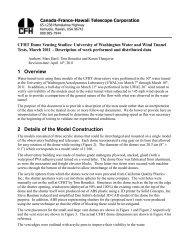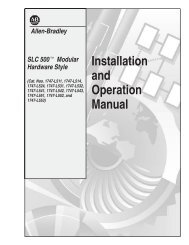Documentation [PDF] - Canada France Hawaii Telescope ...
Documentation [PDF] - Canada France Hawaii Telescope ...
Documentation [PDF] - Canada France Hawaii Telescope ...
Create successful ePaper yourself
Turn your PDF publications into a flip-book with our unique Google optimized e-Paper software.
een preferable because of the higher surface density of sources in SDSS and the similarity of SDSS and<br />
CFHTLS filter sets; however the SDSS does not cover the whole CFHTLS survey; only W3 and D2 and<br />
D3 fields have complete coverage.)<br />
To match CFHTLS and 2MASS catalogues we choose a source matching radius (CROSSID_RADIUS) of<br />
2.0 arcsec for all Wide and Deep fields. A 3 rd order polynomial distortion model is then derived by<br />
minimizing a weighted quadratic sum of differences in positions between the 2MASS and the QFITSin<br />
matched sources, and, internally, between different QFITS-in catalogues with overlapping regions of<br />
MegaCam images (see Fig. 21). Scamp then computes the astrometric internal errors from the differences<br />
of astrometric positions of sources inside the overlapping regions and the external errors from the<br />
comparisons of astrometric positions of MegaCam sources with the 2MASS catalogue.<br />
Images are calibrated separately for each of the four Wide and four Deep fields. However, in order to<br />
take full advantage of L99 photometric images, processing is done in two steps:<br />
• Astrometric calibration – this includes all types of images: science images, short and L99 photometric<br />
calibration images, r-band astrometric anchor pre-survey exposures and supplementary<br />
VIPERS-DDT (discretionary time) exposures for filling missing half-CCDs in W1.<br />
• Initial photometric rescaling – this includes only science images and photometric bootstrapping<br />
(Q98 - Observing Programs Identificators 15 ) images and it uses the astrometric solution from the<br />
previous step. The primary goal of this step is to compute the relative rescaling of the individual<br />
images in each pointing before stacking. The absolute photometry is then anchored to the L99<br />
exposures (see the procedure described in Section 3.7).<br />
In addition, due to the large number of exposures in some of the fields the astrometric calibrations cannot<br />
be solved globally (due to memory requirements) and are additionally split by filter. For those fields<br />
the large number of observing runs produces too many astrometric contexts which cannot be handled<br />
by Scamp using current Terapix computing resources. For this reason, the astrometric calibration is<br />
computed in a field-dependent way.<br />
For the W1 field, for which the astrometric solution is derived with respect to a reference catalogue we<br />
use this procedure:<br />
• We first combine (r, i/y) .ldac catalogues of the science exposures as well as the r-band Wide presurvey<br />
astrometric anchoring images and find an astrometric solution using the 2MASS reference<br />
catalogue and use this to produce an internal (r, i/y) astrometric reference catalogue, calibrated<br />
with 2MASS;<br />
• We then run Scamp on all W1 exposures using this internal reference catalogue on the (u, g), (r, z),<br />
and (i/y) samples separately. The homogeneity and consistency of the calibrations are ensured by<br />
the common r-band Wide pre-survey data used for all samples.<br />
For W2, W3 and W4 fields, the astrometric solution is calculated once for each field by considering all<br />
selected images simultaneously, regardless the filter, exposure type or epoch, using 2MASS. In this way<br />
all images of a given Wide field are calibrated globally and in a homogeneous way.<br />
All Deep fields are calibrated with SCAMP in a similar way as W1. However, the image selection used to<br />
construct the internal reference catalogue is done differently:<br />
15 http://www.cfht.hawaii.edu/Science/CFHTLS-DATA/cfhtlsprograms.html<br />
8


![Documentation [PDF] - Canada France Hawaii Telescope ...](https://img.yumpu.com/26965302/20/500x640/documentation-pdf-canada-france-hawaii-telescope-.jpg)









